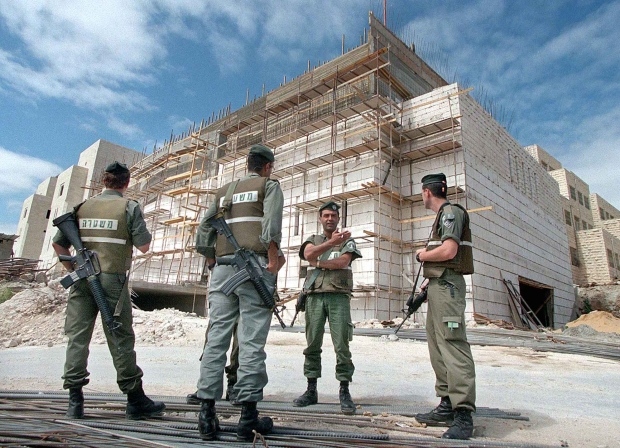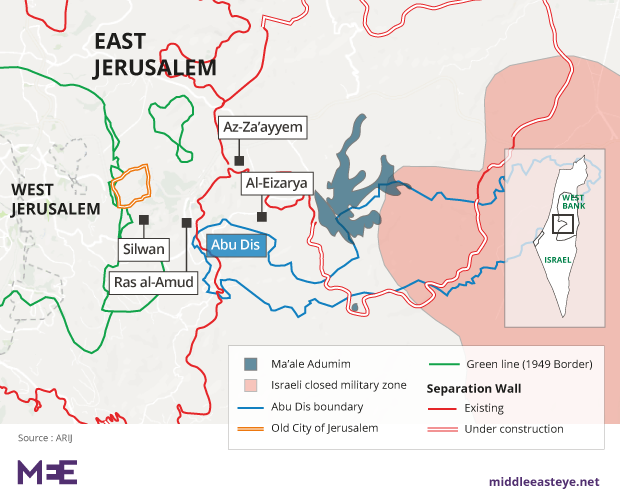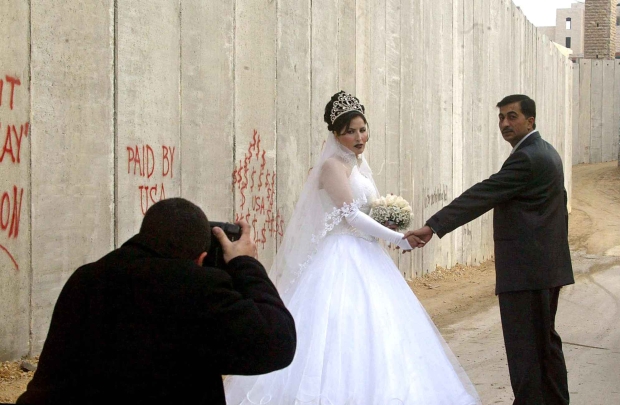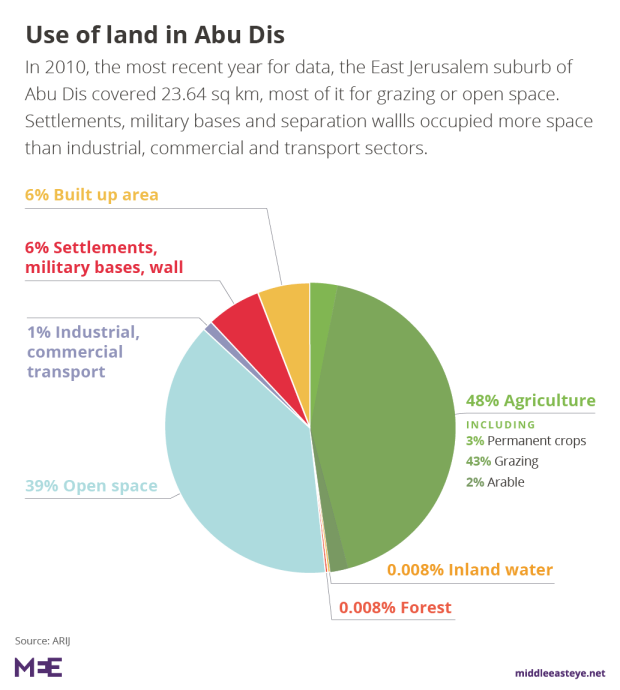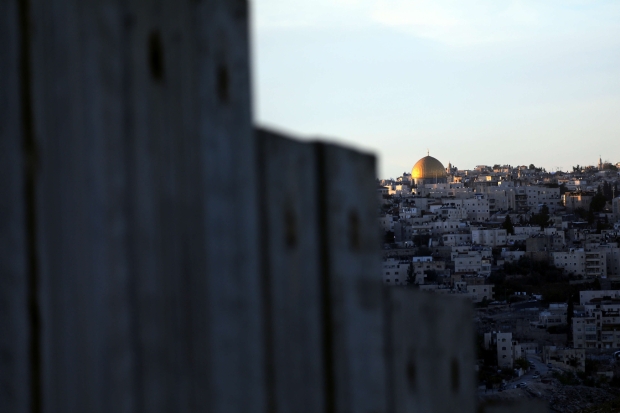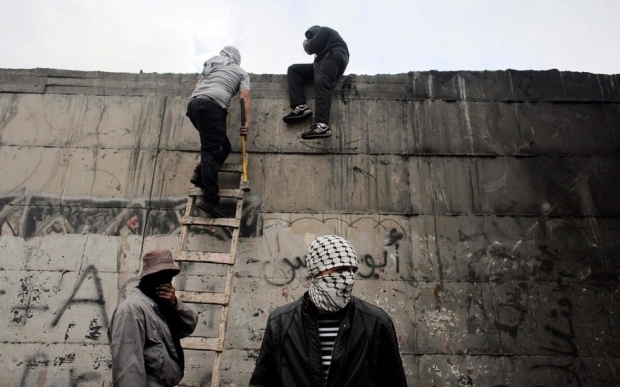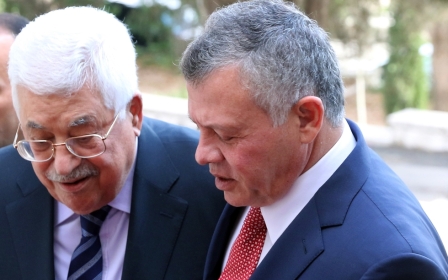Abu Dis: The Palestinian 'capital' Saudi Arabia wants to force on Abbas
It was once a small rural village, noted for its fields of olive trees and spectacular views, overlooking the Old City of Jerusalem to the south-west and the Jordan Valley to the east.
But now Abu Dis is a name spoken by Saudi Crown Prince Mohammed bin Salman as a potential capital of a future Palestinian state, as reported in the New York Times on 3 December.
This small East Jerusalem suburb was flung into the spotlight a few days later by Donald Trump's announcement that the United States would recognise Jerusalem as the capital of Israel.
The decision shook the Palestinian Authority: it hoped that if Washington was ever to make such a declaration then it would also regard East Jerusalem as the future capital for a Palestinian state, especially after years of US-sponsored talks with the Israelis.
But the suggestion that it could instead be Abu Dis flies in the face of the Oslo Accords of 1993 that foresaw East Jerusalem as the eventual capital of a future state.
Why is Abu Dis being discussed?
Abu Dis is regarded as a potential home to a Palestinian government for two reasons.
The first is geographical. Abu Dis is the closest geographical point to the Old City, which houses some of Islam's holiest sites including the al-Aqsa mosque, managed and controlled by the Jerusalem Islamic Waqf, a religious trust.
The five-storey-high complex occupied 1,300 sqm, cost an estimated $4m at the time and had a large meeting hall, from which you can see the Dome of the Rock, surrounded by the minarets of the Old City.
But the Palestinian Legislative Council project came to a halt in 2000, when Palestinian MPs refused to accept any legislative body which was not based in the Old City of Jerusalem. Instead they preferred a stop-gap institution based in Ramallah, at least until a final peace settlement was eventually reached with the Israelis.
In the same year, the Camp David negotiations between Palestinian leader Yasser Arafat and Israeli prime minister Ehud Barak stalled, followed by the start of the second Intifada in September.
Abu Dis, which was under Palestinian civil control in 2000, was reported by The Guardian at the time to be part of the talks, although it is unclear whether it was offered by the US and the Israelis to Arafat as the Palestinian capital.
Abu Dis was seen as a potential place for Arafat to "look out on to a stunning view of the Dome of the Rock". But, as the Guardian reported, the Israeli right did not accept the idea as they wanted Jerusalem as "undivided and eternal".
The second reason Abu Dis is being considered is because of Saudi Arabia. On 3 December, just days before Trump's announcement, The New York Times reported that the suburb had been suggested to Palestinian President Mahmoud Abbas as a possible capital by Mohammed bin Salman.MbS, the paper said, wanted to "force a settlement on Palestinians in order to cement Israeli cooperation against Iran". Riyadh regards Tehran as a regional rival, especially in Yemen, Iraq, Syria and Lebanon, and is keen for Israeli support against it.
The Saudi plan, the Times reported, would ensure that "the Palestinians would get a state of their own but only noncontiguous parts of the West Bank and only limited sovereignty over their own territory. The vast majority of Israeli settlements in the West Bank, which most of the world considers illegal, would remain. The Palestinians would not be given East Jerusalem as their capital, and there would be no right of return for Palestinian refugees and their descendants".
All of this would be "sweetened" with vast financial aid from Riyadh to the PA. Abbas has yet to comment on the idea, but was due to travel to Riyadh on Wednesday for talks with King Salman and MbS about the US recognition of Jerusalem as Israel's capital.
Crusades, views and weddings
It's a lot of attention for what, to the casual observer, is an average Palestinian suburb. Abu Dis, whose population currently numbers an estimated 12,600 Palestinians, lies 3.8km from the eastern wall of the Old City of Jerusalem. The name is believed to have derived from the ancient Greek phrase for "mother of 10 villages".
For centuries, Abu Dis has been a place of contention. In 1187, the army of Saladin, the Muslim military and political leader, camped on its hills before liberating Jerusalem from the Crusaders.
The views from the east and west of the suburb, which sits 628 metres above sea level, are breathtaking. On a clear morning, you can see the Dead Sea and the hills of Jericho with their short red grass. To the west are the walls of the Old City and the golden Dome of the Rock.
Its expansion started in 1967, following the Arab-Israeli War, when Palestinian land was confiscated by Israeli authorities. This forced residents of Abu Dis to build housing on land previously used for agriculture, spurred on by the lack of sufficient Israeli building permits for Palestinians in East Jerusalem. At-Tur, Ras Al-Amud, Abu Dis and Al-Eizariya also expanded until they all coalesced to form one large urban area.
The area was changed, first by the Oslo Accords, which created a patchwork of control across the West Bank, then by the construction of the Separation Wall
Abu Dis was not noted for its culture until 1984 when the Al-Quds University opened and students flocked from Jerusalem and Palestinian cities.
But the face of the area was changed, first by the Oslo Accords of the early 1990s, which created a patchwork of control across the West Bank, then by the construction of the separation walls from 2002.
Now Abu Dis is crammed with tower blocks. A single road runs through from Al-Eizariya to the north. Both suburbs are used as wedding locations, a place where Palestinians from Hebron, Bethlehem and Ramallah who hold PA-issued green ID cards - and so are denied entry to the Old City - meet with friends and family from East Jerusalem, who hold the Israeli blue ID cards.
How Abu Dis lost control
Talk of Abu Dis as a Palestinian capital seems optimistic on paper for several reasons, not least the fractured nature of the suburb.
The area, like elsewhere on the West Bank, is now a series of zones where Palestinian rights are precarious or non-existent as ownership of the land has been eaten away by Israeli priorities over the years.
According to 2012 report by the Applied Research Institute in Jerusalem, Abu Dis town area is currently 23.6 sq km.
In 1967, it, like the West Bank and Gaza, fell under Israeli occupation. Since then, there have been a series of land confiscations for Israeli settlements, military bases and the separation wall.In 1975, Israel seized one square kilometre to build the Ma'ale Admum settlement, followed by a further 0.4sq km in 1980 to create the Mizpe Yedud settlement.
Then there is the separation wall, which Israel started building in 2002, and divides Abu Dis from the Old City and extends more than eight kilometres around the suburb.
The wall has also made it much harder for residents to reach the Old City. Now Palestinians have to drive in the opposite direction to their destination, then veer north through Area C, which is under full Israeli military and administrative control. They then take the road connecting Jerusalem with Jericho, before passing the Al-Za'im checkpoint, a major checkpoint on the West Bank.
The Oslo II Interim Agreement of 1995 classified land on the West Bank as falling under Area A (where the Palestinian Authority has full civil and security control), Area B (where the Palestinian Authority shares full civil and joint security control with Israeli authorities) or Area C (where the Israeli authorities have full civil and security control).
Around 3.5 km sq of Abu Dis - or 14.8 percent - is classified as Area B. But most of the suburb - around 20 sq km or 85 percent - is classified as Area C and under Israeli control.
It has left residents with little land on which to develop housing and infrastructure. Palestinians are prohibited from building and managing their land in Area C without a permit from the Israeli Civil Administration, a body led by a military commander in the West Bank.The 2012 report by the Applied Research Institute said that following the completion of the segregation wall, almost 11.1 sq km - or 47 percent - of Abu Dis would be isolated, including urban areas, agricultural land and open spaces.
To the west, the report said, would be a section of the wall, isolating it from Jerusalem. To the east would be another wall, with the Israeli settlement of Ma'ale Adumim to the north.
Take health care. The separation wall prevents Palestinian from driving 10 minutes to the Al-Makassed Hospital at the Mount of Olives. Instead, they have to travel to Ramallah or Bethlehem to seek medical treatment, a journey that takes at least an hour driving along Israeli-controlled roads to get to the PA-controlled areas.
Palestinians condemn proposal
The majority of Palestinians oppose Abu Dis as their capital. So when news leaked of the Saudi offer, the reaction was quick - and sharp. Many retweeted hashtags which said that Jerusalem (Al-Quds) is the capital of Palestine, which gained in popularity after Trump's recognition announcement.
Haifa Wehbe, one of the most famous Arab pop stars, said that "Jerusalem is the eternal capital of Palestine"...
...while others showed their support through art...
Translation: A mural in occupied Palestine, stronger than all slogans: I can see. Jerusalem is the capital of Palestine.
Ahmed Azem, a political analyst at Birzeit University, said that "offering Abu Dis as the capital is not new. It was circulated in 2000 before the talks of Camp David to make Abu Dis as the Palestinian state capital, but this did not happen.
Rana al-Sheikh Qasem, a media graduate from Al-Quds University, said that "the journey to and from Jerusalem to Abu Dis is extremely long and exhausting. The Israeli occupation made it hard for us to visit the Old City. Israel does not want Palestinians in Jerusalem. All these settlements, checkpoints and the separation wall are there to push us to live on a minimum portion of land."
I can't but see Jerusalem as the capital for all Arabs and Palestinians
- Heba Erekat
Even residents of Abu Dis are not taken by the idea.
Heba Erekat, 31, said: "My school was a seven-minute drive from my house, but because of the Israeli separation wall, the journey became at least an hour's drive.
"This is a pathetic proposal, and we consider it as a joke. Although I am proud being a resident of Abu Dis, I can't but see Jerusalem as the capital for all Arabs and Palestinians."
This article is available in French on Middle East Eye French edition.
Middle East Eye propose une couverture et une analyse indépendantes et incomparables du Moyen-Orient, de l’Afrique du Nord et d’autres régions du monde. Pour en savoir plus sur la reprise de ce contenu et les frais qui s’appliquent, veuillez remplir ce formulaire [en anglais]. Pour en savoir plus sur MEE, cliquez ici [en anglais].


